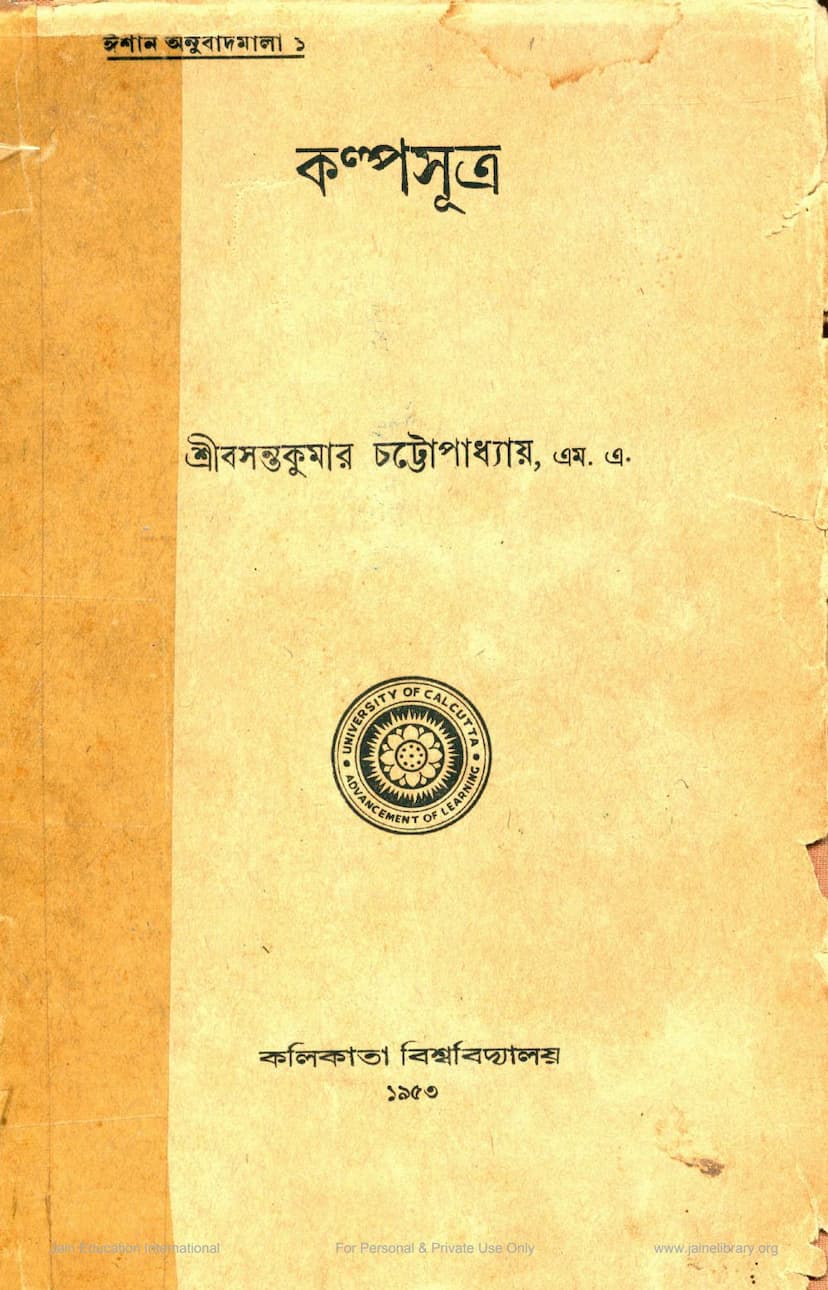Kalpasutra
Added to library: September 2, 2025

Summary
This is a comprehensive summary of the provided Jain text, the Kalpasutra, based on the provided Bengali text and catalog link.
Book Title: Kalpasutra Author: Basantkumar Chattopadhyaya Publisher: Calcutta Vishvavidyalaya (University of Calcutta) Publication Year: 1953 Series: Ishan Translation Series (Ishan Anuvadmala) - First Publication
Overview:
The Kalpasutra is a significant and widely accepted ancient Jain scripture, belonging to the category of "Chedasutras" (texts dealing with monastic discipline and expulsion). It is an integral part of the Jain Agamas (scriptures) of the Shvetambara tradition. This particular publication, edited and translated by Basantkumar Chattopadhyaya, includes the original Ardhamagadhi Prakrit text, a Bengali translation, an introduction, commentary, glossary, and an index. The work is dedicated to the memory of the late Ishanchandra Ghosh, a promoter of education and translator of Buddhist texts into Bengali.
Key Components of the Kalpasutra (as described in the text):
-
Origin and Authorship: The Kalpasutra is attributed to the Jain Acharya Bhadrabahu, who is believed to have composed it in the 4th century BCE. It is considered the fourth chapter of the "Achardashaha" or "Dashatakskandha" text within the Chedasutras.
-
Content: The primary focus of the Kalpasutra is on the lives of important Jain figures, particularly the Tirthankaras and other great souls. It also includes teachings on Jain spiritual philosophy, the conduct of Jain ascetics (monks and nuns), and discussions with other philosophical schools that differed from Jainism. The text is noted for containing biographical accounts of key figures like Mahavir Swami, who lived contemporary to Buddha.
-
The Agamas: The introductory sections of the book describe the Jain Agamas, which form the core of Jain religious literature for the Shvetambara sect. These consist of 45 different texts divided into categories: 11 Angas (primary texts), 12 Upangas (secondary texts), 10 Prakirnakas (miscellanea), 6 Chedasutras, 2 special texts (Nandi Sutra and Anuyogadvāra), and 4 Mulusutras (root texts). All these were originally composed in Ardhamagadhi Prakrit and collected around the 5th century CE.
-
Bhadrabahu: The text highlights the importance of Bhadrabahu as the author of the Kalpasutra. It notes that Bhadrabahu was a prominent Jain Acharya and the sixth in the lineage of Mahavir Swami's disciples. His significant contribution includes spreading Jainism in South India, particularly in Karnataka, where he is credited with establishing a strong Jain presence. The text mentions historical evidence from Kannada literature and epigraphy supporting his influence.
-
Historical Context and Significance:
- The publication of this work is seen as a significant event in Bengali scholarship concerning ancient Indian studies.
- The Kalpasutra is identified as a part of the larger Jain literary tradition, which is comparable in antiquity, scope, and value to Buddhist literature.
- The introduction touches upon the historical development of Indian religions, including the rise of Brahmanism, Jainism, and Buddhism, emphasizing the philosophical debates and the interaction between Aryan and non-Aryan cultures.
- It mentions that Jain literature exists in Sanskrit, various Prakrits, Apabhramsa, Tamil, and Kannada, representing a significant portion of Indian literary heritage.
-
The Ishan Translation Series: This book is the first publication of the "Ishan Translation Series," established by Professor Prafullachandra Ghosh through a fund endowed by his father, Ishanchandra Ghosh. The fund's purpose is to publish high-quality translations of important works into Bengali.
-
Editorial and Translation Work: The editor and translator, Basantkumar Chattopadhyaya, is noted for his extensive work, including providing a necessary introduction, glossary, and annotations. He followed the text compiled by the renowned scholar H. Jacobi. The translation is presented side-by-side with the original Ardhamagadhi text for ease of comparison and study.
-
Content of Introduction and Appendices: The book includes an introduction ("Avataranika") that discusses the fundamental elements of Jainism in ancient literature, Jain literature in general, and the Ardhamagadhi language. It also delves into the historical context and Bhadrabahu's contributions.
-
Ardhamagadhi Language: The text provides a detailed discussion on the Ardhamagadhi language, its characteristics, and its relation to Pali. It explains how Ardhamagadhi, used by Mahavir Swami for his teachings to be accessible to a broader audience, was a synthesized language incorporating elements from Magadhi and other regional dialects. It also details phonetic and grammatical features of Ardhamagadhi, including sound changes and declensions.
Dedication: The book is dedicated to the memory of Ishanchandra Ghosh, who significantly contributed to Bengali literature by translating the entire Pali Jataka stories.
Publisher's Role: The University of Calcutta is commended for undertaking this publication, contributing to the mental and cultural enrichment of the Bengali populace and the Jain community.
In essence, this publication of the Kalpasutra aims to make this foundational Jain text accessible to Bengali readers, highlighting its historical, philosophical, and literary significance within the broader context of Indian religious and cultural history. It also acknowledges the important role of Ishanchandra Ghosh and his son in promoting such scholarly endeavors.